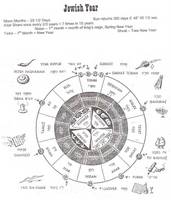Liturgy Team members at St. Julie Billiart, San José
On Sunday, January 23rd at 3:00 PM, my wife, Diane, and I attended an Open House at Congregation Shir Hadash in Los Gatos. The theme of the Open House was the Mitzvah (commandment) of writing a Torah scroll. This is the fulfillment of the final commandment of the Torah. Congregation Shir Hadash is a community of approximately 550 families that is celebrating their 25th Anniversary.
We were greeted by Rabbi Melanie Aron, who gave us a brief history of Congregation Shir Hadash and who explained the agenda for the Open House. The agenda was in three parts – the Jewish calendar, the Writing of the Torah, and the Holocaust Torah. We were then divided into three groups, with each group attending one of the agenda items. We began in the sanctuary with the Jewish calendar.
 Dianne Portnoy conducted this session on the Jewish calendar. Dianne first explained the significance of the Menorahs in the temple sanctuary. These were seven branch menorahs not the nine branch menorahs that we are more familiar with during the celebration of Hanukkah. The seven branch menorah represents the six days of creation and the day of rest. Dianne then gave a brief description of the Torah. The Torah is the first five books of the bible, written by Moses. Unlike our bible which is produced by printing presses, the Torah must be hand copied from the previous Torah.
Dianne Portnoy conducted this session on the Jewish calendar. Dianne first explained the significance of the Menorahs in the temple sanctuary. These were seven branch menorahs not the nine branch menorahs that we are more familiar with during the celebration of Hanukkah. The seven branch menorah represents the six days of creation and the day of rest. Dianne then gave a brief description of the Torah. The Torah is the first five books of the bible, written by Moses. Unlike our bible which is produced by printing presses, the Torah must be hand copied from the previous Torah.  The significance here is that all Torahs are identical going back to the original Torah of Moses. Next, Dianne described the Jewish calendar. The Jewish faith celebrates many more high holy days than the Christian faith. All of these high holy days are described in the Torah along with when they are to be celebrated. The Jewish calendar is primarily lunar but with some solar influences. A copy of this year’s Jewish calendar is to the right of this article. We then proceeded to the library for the second part of the agenda, the writing of the Torah.
The significance here is that all Torahs are identical going back to the original Torah of Moses. Next, Dianne described the Jewish calendar. The Jewish faith celebrates many more high holy days than the Christian faith. All of these high holy days are described in the Torah along with when they are to be celebrated. The Jewish calendar is primarily lunar but with some solar influences. A copy of this year’s Jewish calendar is to the right of this article. We then proceeded to the library for the second part of the agenda, the writing of the Torah.We were greeted by Rabbi Moshe Druin, a sofer or official scribe, who lives in Florida and travels all over the world writing new Torahs. A sofer or scribe goes through very extensive and difficult training. Even then not all succeed in becoming a scribe. Rabbi Druin explained that special parchment and ink must be used in creating a Torah. As was mentioned earlier, it must be an exact copy of the previous Torah scroll. Nothing can be added, such as the scribe’s name or date of creation, and nothing can be deleted. The entire community takes part in writing the scroll and it takes approximately one year to complete. Rabbi Druin also explained that as a scroll ages with time and use, parts will eventually be damaged. These parts can and must be repaired. When a scroll reaches a point where it can no longer be repaired, it must be buried. We then proceeded to the school for the third part of the agenda, the Holocaust Torah.
Helayne Green conducted this most unforgettable session. Helayne was part of a group that traveled to Auschwitz in Poland to commemorate the liberation of the prison camp by the Russians. They also took part in the March of the Living where they walked along the railroad tracks from Auschwitz prison camp to nearby Birkenau just as the prisoners did during World War II. The day before they were to fly to Israel, a few of the students found two Torah scrolls in an old bookstore, which they immediately purchased. Fortunately they were able to get them out of Poland to Israel the next day. They were authenticated in Israel to have been written sometime in the early 1920’s. Somehow they survived the Holocaust although badly damaged. The scrolls ended their journey in San Diego, where one remains today. The other was obtained by Congregation Shir Hadash, where it will be restored. Approximately 40% of the scroll was damaged and will be repaired at a cost of approximately $15,000 over a six month period. We were actually allowed to touch it. Helayne also told us that anti-Semitism is on the rise again in Europe.
After that there was a reception and refreshments. We were able to talk with Rabbi Melanie Aron and many of her congregation. The exchange of information and sincere interest was overwhelming. Just as at St. Julie’s, where All are Welcome, so it was also at Congregation Shir Hadash. We thank Rabbi Melanie Aron and Congregation Shir Hadash for their hospitality and the opportunity to experience such a moving interfaith event. It was a wonderful educational experience and we both hope to be able to attend more of these types of interfaith events.
No comments:
Post a Comment